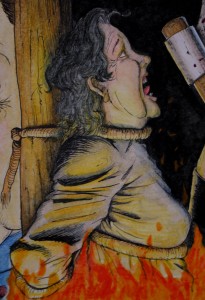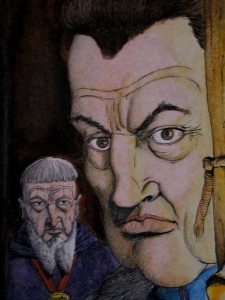You might think that as the illustrator for Witch Hunts, all the research would have been done solely by Rocky and Lisa right? Well, yes, but that’s not to say I didn’t have my nose firmly buried in books as well.
Given the graphic novel deals with about 400 years of European and Colonial American history, my illustrations had to be historically accurate, right down to the last detail. Yes, I could use artistic license in some cases and imagine what locales and people might have looked like, but I was also very eager to ensure the book was authentic.
During the nine months or so that I was hunched over the drawing desk (not unlike Heinrich Kramer, but without the misogyny!), I had to refer to many different texts and art books in order to bring the story of Witch Hunts to life.
Thank goodness then for libraries and the Internet, which provided me with a plethora of artistic material; fashions of the era, architecture, hairstyles, headwear (oh, god the hats drove me insane!) and of course the numerous instruments of torture.
Three books that proved invaluable to me were: The Chronicle of Western Costume: from the Ancient World to the Late Twentieth Century, by John Peacock, An Illustrated History of European Costume : Period Styles and Accessories, by Auguste Racinet, and Medieval Panorama, edited by Robert Bartlett.
Peacock’s book had page after page of clothing from peasants to royalty and I photocopied so much of that book that I should have just bought myself a copy! The other tome was filled with paintings, woodcuts and metal work from the Middle Ages and lots of exposition on how people lived and worked at the time.
Other books I borrowed out way too many times included Knights, by Andrea Hopkins, The Flowering of the Middle Ages edited by Joan Evans and What Life Was Like in the Age of Chivalry, from Time-Life Books.
Costumes for the Salem chapter were sourced entirely from the Internet, with imagery from the film and theatrical versions of The Crucible being readily available. Lisa’s chapter on King James of Scotland was a little trickier as I had to find, among other things, an engraving of his old castle Holyrood House – before it was burned down and rebuilt. I also had to find an appropriate sailing ship specific to the 16th Century (Lisa didn’t make things easy for me!)
The only real trouble I had was finding any images of the witch hunters Jacob Sprenger and Heinrich Kramer. The only pictures I could find came from a thumbnail of the cover of an old Spanish edition of their book the Malleus Maleficarum. It helped give me an idea of what Sprenger might have looked like, but Kramer’s appearance I had to come up with myself.
The torture implements came from the web as well with one very thoughtful (or obsessive person?) even compiling them all into one PDF and putting them on the Internet for all to see.
Strangely though, for a book about witches, I didn’t have to draw many of them. There was only one page where I drew them with the stereotypical characteristics that we associate with witches – the pointed black hat and warty face. The victims of the witch craze were normal-looking people of differing ages.
All in all this was the largest art project I’ve ever undertaken (around 185 illustrated pages!), not counting the few pages I did that weren’t suitable. I spent many nights (I work full time during the day) at the drawing desk after my kids went to bed, trying my very hardest to capture the history of this truly terrible time in the age of man. Rocky and Lisa’s text is very important in my view and I hope I have done it justice. I hope I meet readers’ expectations.
And to the artists who came before me and inspired me during my time on Witch Hunts, I say thank you!
 Witch Hunts co-author Rocky Wood has discussed his work on the Witch Hunts graphic novel and his commitment to the Horror Writers Association and Stephen King research, despite being diagnosed with ALS (Lou Gehrig’s Disease) in 2010.
Witch Hunts co-author Rocky Wood has discussed his work on the Witch Hunts graphic novel and his commitment to the Horror Writers Association and Stephen King research, despite being diagnosed with ALS (Lou Gehrig’s Disease) in 2010.






